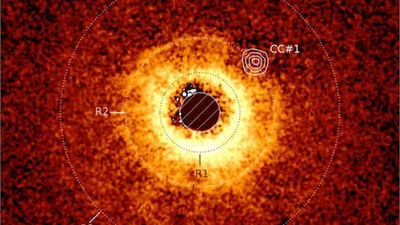The James Webb Space Telescope (JWST) has achieved a milestone by directly imaging a newly discovered planet, TWA 7b, marking its first such find after three years of studying exoplanets. This young exoplanet is the lowest-mass planet ever directly observed outside of our solar system. TWA 7b has a mass approximately 0.3 times that of Jupiter, or about 100 times that of Earth, making it ten times lighter than any previously directly imaged exoplanet.

Image: An artist's impression of the newly discovered exoplanet TWA 7b.
TWA 7b orbits CE Antliae (TWA 7), a young, low-mass star located 111 light-years away in the constellation Antlia. The star, part of the TW Hydrae Association, is estimated to be just 6.4 million years old, making it an ideal target for JWST due to its youthful nature and orientation.
The discovery of TWA 7b was made possible through infrared imaging, a specialty of JWST. Young, low-mass planets emit thermal radiation in the infrared spectrum. The telescope’s Mid-Infrared Instrument (MIRI) and its coronagraph were crucial to the finding.
A coronagraph blocks the overwhelming light of a star, enabling the detection of faint nearby objects, like exoplanets. The JWST team used high-contrast imaging to identify a faint infrared source within the debris disc around TWA 7.
This faint source was located in a gap between rings of dust, an area expected to be formed by a planet's gravitational influence. Simulations confirmed that a planet with the mass of Saturn in that location would explain the observed structure.
The disc surrounding TWA 7 contains three distinct rings with gaps. One of these gaps features a narrow ring flanked by dust-free regions, a pattern often associated with the gravitational forces of an orbiting planet. The infrared glow detected by JWST aligns with this ring gap, and its brightness, temperature (around 320 Kelvin or 47°C), and orbital distance (about 50 astronomical units from the star) match the characteristics scientists expected of a planet in this region.
The discovery of TWA 7b is significant for several reasons:
Astronomers believe that debris discs around young stars provide insights into planetary formation. The rings and gaps within these discs indicate zones where material is either accumulating to form planets or being cleared out by their gravitational pull. TWA 7b may be the first direct evidence of this process.
Researchers utilized advanced image subtraction methods to detect TWA 7b. By removing residual starlight, they could isolate the planet from other celestial bodies and background galaxies. This discovery demonstrates how new observing methods and instruments on JWST, like the coronagraph and MIRI, are expanding our ability to discover previously inaccessible exoplanets. JWST's mid-infrared sensitivity allows it to detect planets as massive and cold as Saturn, which represents a significant improvement in direct imaging capabilities.
JWST’s ability to suppress starlight and detect the faint heat signatures of small, cold planets opens a new era in exoplanet discovery. Astronomers are optimistic that even lighter planets, possibly Neptune-mass or even super-Earths, will soon be detectable.
Future observations will focus on:
Newer articles
Older articles
 Chess Star Praggnanandhaa Weighs In on Carlsen's Frustration After Loss to Gukesh
Chess Star Praggnanandhaa Weighs In on Carlsen's Frustration After Loss to Gukesh
 Samsung Galaxy A35 5G and A55 5G: Official Pricing and Availability Announced
Samsung Galaxy A35 5G and A55 5G: Official Pricing and Availability Announced
 India's Fielding Woes Blamed for First Test Defeat Against England: Former Selector Voices Concerns
India's Fielding Woes Blamed for First Test Defeat Against England: Former Selector Voices Concerns
 Headline: Viral Optical Illusion: Can You Find All the Hidden Animals? Only 1% Succeed
Headline: Viral Optical Illusion: Can You Find All the Hidden Animals? Only 1% Succeed
 Shadman Stands By Bangladesh Batters After Day 1 Struggles Against Sri Lanka
Shadman Stands By Bangladesh Batters After Day 1 Struggles Against Sri Lanka
 Norris Claims Thrilling Austrian GP Victory After Intense Duel with McLaren Teammate Piastri
Norris Claims Thrilling Austrian GP Victory After Intense Duel with McLaren Teammate Piastri
 Jake Paul's Title Dreams: Analyzing Championship Prospects and Potential Opponents
Jake Paul's Title Dreams: Analyzing Championship Prospects and Potential Opponents
 Gavaskar Urges India to Unleash Kuldeep Yadav in Second Test Amid Bumrah Fitness Concerns
Gavaskar Urges India to Unleash Kuldeep Yadav in Second Test Amid Bumrah Fitness Concerns
 iQoo Z9 Turbo Leaks: Snapdragon 8s Gen 3, 1.5K Display, and Massive Battery Detailed
iQoo Z9 Turbo Leaks: Snapdragon 8s Gen 3, 1.5K Display, and Massive Battery Detailed
 Mirabai Chanu Reveals Relentless Dedication: Training and Weight Always Top of Mind, Even During Family Time
Mirabai Chanu Reveals Relentless Dedication: Training and Weight Always Top of Mind, Even During Family Time